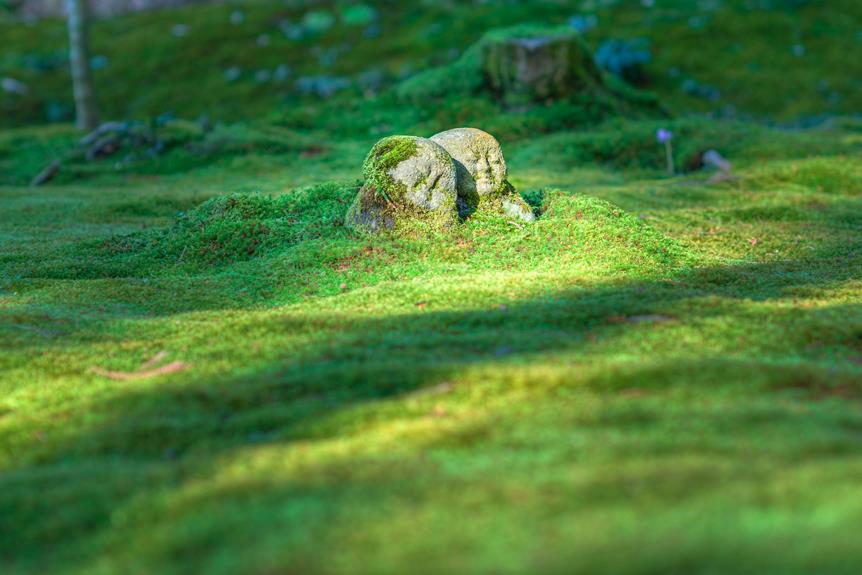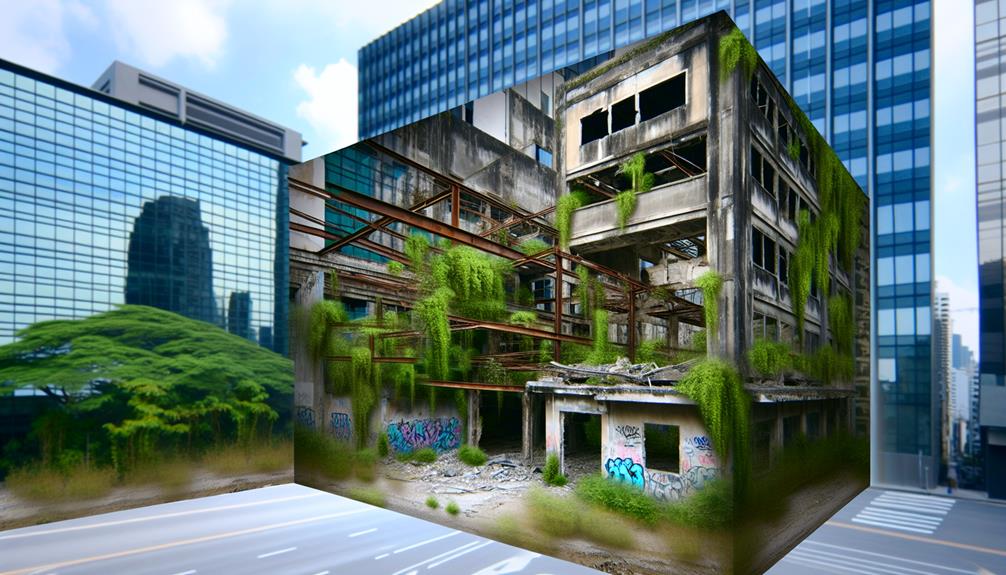Nestled off the coast of Japan lies Hashima Island, a place steeped in a rich tapestry of history and mystery. Once a bustling coal mining community, its abandoned structures now whisper tales of a bygone era, shrouded in intrigue and nostalgia. As the island's haunting past slowly emerges from the shadows, questions arise about the lives lived among its crumbling buildings and deserted streets. What secrets lie buried beneath its surface, waiting to be unearthed by those curious enough to seek them out?
Key Takeaways
- Hashima Island has a rich history of industrial development and wartime significance.
- Abandoned structures offer ghostly urban exploration experiences.
- Sustainable tourism practices are implemented to preserve the island's historical significance.
- Photography enthusiasts can capture unique architectural features and historical remnants.
- The island reflects the impermanence of human constructions through decaying buildings and nature reclaiming the land.
History of Hashima Island
Hashima Island's history is a compelling narrative that intertwines industrial development, wartime significance, and eventual abandonment, showcasing the island's complex and layered past. One of the central elements of this history is the island's mining operations, which played a pivotal role in shaping its trajectory. In the late 19th century, Hashima Island became a hub for coal mining, attracting workers from all over Japan to toil in its underground tunnels. The demand for coal during this period fueled the island's rapid industrialization, transforming it into a bustling center of production.
However, this industrial boom came at a cost, as the mining operations on Hashima Island were often fueled by forced labor. During World War II, the island's strategic importance led to the use of forced labor, with Korean and Chinese prisoners subjected to harsh conditions in the coal mines. This dark chapter in Hashima Island's history highlights the human rights abuses that took place in the pursuit of economic growth.
The legacy of mining and forced labor looms large over Hashima Island, serving as a stark reminder of the complex interplay between industrial development and social injustice. Despite its eventual abandonment in the 1970s, the island's history continues to resonate, prompting reflection on the ethical implications of unchecked industrialization.
Industrial Boom and Decline
The culmination of Hashima Island's industrial history saw a period of rapid economic growth followed by a stark decline as shifting global trends and economic factors impacted the island's industrial landscape. Originally thriving as a coal mining facility, Hashima Island experienced a significant rise during the industrial boom of the early 20th century. The demand for coal, fueled by Japan's industrialization, led to a flourishing economy on the island, attracting a large workforce and substantial investments.
However, as the global energy landscape evolved, moving away from coal towards alternative sources, Hashima Island faced a rapid decline. The once bustling mining operations dwindled, leading to layoffs and economic hardships for the island's inhabitants. The fall of the coal industry had a profound economic impact on Hashima, resulting in a sharp decrease in population and a struggling local economy.
The rise and fall of Hashima Island's industrial sector serve as a poignant example of the economic volatility that can accompany dependence on a single industry. The island's story reflects the broader challenges faced by industrial communities worldwide when confronted with shifting economic paradigms and global market forces.
Life on the Abandoned Island
Amidst the decaying remnants of industry and infrastructure, the abandoned island of Hashima stands as a haunting witness to a bygone era of economic prosperity and decline. Once a bustling coal mining facility, Hashima, also known as Gunkanjima (Battleship Island), now lies desolate, its abandoned structures telling a poignant tale of human endeavor and subsequent abandonment.
Exploring solitude on Hashima Island reveals a sense of eerie tranquility. The empty apartments, schools, and shops evoke a ghostly presence of the past inhabitants who once thrived in this isolated community. The silence that envelops the island only amplifies the feeling of isolation, offering visitors a moment to reflect on the transient nature of industrial progress.
Walking through the abandoned structures, one can witness the passage of time through the decay and neglect that have befallen the once-thriving buildings. Nature has started to reclaim its territory, with vines creeping through cracked walls and sea salt corroding concrete structures. Each crumbling edifice stands as a confirmation to the impermanence of human constructions in the face of nature's relentless advance.
Life on the abandoned island of Hashima is a stark reminder of the fleeting nature of economic booms and the lasting impact they leave behind. As visitors navigate the deserted streets and dilapidated buildings, they are confronted with the complex interplay between progress, abandonment, and the enduring legacy of human presence.
Ghostly Urban Exploration
With an air of solemn intrigue, the abandoned structures on Hashima Island invite daring explorers to investigate the world of ghostly urban exploration. As visitors step foot onto the desolate island, they are enveloped by an eerie atmosphere that seems to whisper tales of the past. The crumbling buildings, once bustling with life, now stand as ghostly remnants of a bygone era, shrouded in mystery and intrigue.
For those who dare to venture into the abandoned corridors and rooms, paranormal encounters are not uncommon. Many explorers have reported strange sounds echoing through the decaying walls, flickering lights in the distance, and a sense of being watched by unseen entities. These ghostly experiences add to the allure of Hashima Island, drawing in thrill-seekers and paranormal enthusiasts from around the world.
The eerie atmosphere of Hashima Island serves as a stark reminder of its dark history, where thousands of forced laborers toiled under harsh conditions. The island's haunting past is palpable, adding a layer of complexity to the urban exploration experience. As visitors navigate the deserted streets and dilapidated buildings, they cannot help but feel a sense of reverence for the souls who once inhabited this desolate place. Ghostly urban exploration on Hashima Island offers a unique opportunity to explore the mysteries of the past and witness firsthand the lingering spirits of a forgotten community.
Architectural Wonders and Ruins
Nestled among the remnants of a once thriving industrial hub, Hashima Island showcases a mesmerizing blend of architectural wonders and ruins that bear witness to its tumultuous past. The island's structures, such as the imposing concrete apartment blocks and the eerie abandoned industrial facilities, stand as evidence to the rapid industrialization that once characterized the island. Each building holds architectural secrets, reflecting the unique challenges faced by engineers and architects in designing structures to withstand the harsh marine environment and accommodate the island's dense population.
The juxtaposition of modern restoration efforts with the decaying ruins creates a striking visual contrast, offering visitors a glimpse into the island's complex history. While some buildings have been carefully restored to their former glory, others remain in a state of picturesque decay, with nature slowly reclaiming the structures. This interplay between preservation and dilapidation adds to the island's mystique, drawing in urban explorers and history enthusiasts alike.
Despite the ravages of time and neglect, Hashima Island's architectural wonders continue to captivate visitors, sparking curiosity about the stories embedded within its crumbling walls. The island's buildings serve as poignant reminders of a bygone era, where industry reigned supreme, leaving behind a hauntingly beautiful legacy for future generations to ponder.
Preservation Efforts and Tourism
Preservation efforts and tourism on Hashima Island in Japan have become integral components in safeguarding its architectural heritage while also attracting a growing number of visitors keen on exploring its rich history. The island, known for its once thriving coal mining community and now as a UNESCO World Heritage site, faces various preservation challenges due to its remote location and exposure to harsh weather conditions. Efforts to conserve the decaying concrete buildings and prevent further deterioration are ongoing, with a focus on maintaining the authenticity of the site while ensuring its long-term sustainability.
In recent years, sustainable tourism practices have been implemented to balance the influx of visitors with the need for conservation. Guided tours with limited group sizes help minimize the environmental impact on the island, while also providing educational insights into its history. By promoting responsible travel behaviors, such as respecting the fragile structures and following designated paths, visitors play a significant role in supporting preservation efforts.
The unique blend of historical significance and architectural intrigue makes Hashima Island a compelling destination for travelers interested in industrial heritage. As tourism continues to grow, finding the delicate equilibrium between preservation and visitor experience remains paramount to guarantee the longevity of this iconic site.
Photography Tips and Spots
Exploring Hashima Island's unique architectural features and historical remnants offers photography enthusiasts an array of intriguing opportunities to capture the essence of this UNESCO World Heritage site. When it comes to photography on Hashima Island, there are a few key tips and spots that can enhance your experience and help you create stunning images.
One technique that can produce mesmerizing photos on Hashima Island is light painting. By using long exposure settings on your camera and manipulating light sources, such as flashlights or lanterns, you can create mesmerizing effects that highlight the island's eerie atmosphere and abandoned structures.
Additionally, drone photography opens up a whole new perspective for capturing Hashima Island. With a drone, you can capture aerial views of the island's unique layout and gain a better appreciation of its historical significance. Be sure to follow local regulations and guidelines when flying a drone on the island to ensure both your safety and the preservation of this historic site.
Some of the best spots for photography on Hashima Island include the crumbling apartment buildings, the iconic sea wall, and the decaying industrial structures. These locations offer a glimpse into the island's past and provide ample opportunities for creative photography. Whether you're drawn to the island's haunting beauty or its historical significance, Hashima Island presents a wealth of photographic opportunities for enthusiasts willing to explore its unique landscapes and structures.
Frequently Asked Questions
Can Visitors Stay Overnight on Hashima Island?
Accommodation options for visitors on Hashima Island are limited due to safety concerns and preservation efforts. While staying overnight is not currently permitted, day tours offer a glimpse into the island's history and industrial ruins.
Tourists can enjoy local cuisine on nearby islands before returning to the mainland. Safety measures are in place to guarantee a memorable and secure experience for all visitors exploring this unique historical site.
Are There Any Restrictions on Exploring the Island?
Exploration restrictions on the island may include designated paths, prohibited areas for safety or preservation, and supervised tours. Tourist accommodations may be limited or non-existent, requiring visitors to arrange off-island stays.
These measures safeguard the protection of the site's historical and environmental significance while allowing for a controlled and respectful visitor experience. Understanding and adhering to these restrictions is essential for both the preservation of the site and the safety of visitors.
What Wildlife Can Be Found on the Island?
In exploring isolated islands, one can encounter a diverse array of wildlife, from unique bird species to rich marine life. These ecosystems often provide sanctuary for various species, fostering a delicate balance of biodiversity.
Birdwatchers may spot seabirds like albatrosses or petrels, while marine enthusiasts might catch glimpses of colorful coral reefs teeming with fish species.
Understanding and preserving these habitats is essential for the well-being of these wildlife populations.
How Has the Island's Environment Changed Over Time?
Over time, the environment of the island has undergone significant changes. Erosion patterns have altered the landscape, impacting the natural habitat and coastal features.
Industrial pollution has further exacerbated these changes, leading to ecological imbalances and degradation of the ecosystem.
Understanding these shifts is important for evaluating the long-term sustainability of the island and implementing measures to mitigate environmental damage and preserve biodiversity.
Are There Any Hidden Underground Tunnels on the Island?
Exploring history often reveals hidden secrets, and urban legends can add a layer of mystique to any location. Underground tunnels have been a part of many historical sites, sparking curiosity and speculation.
While some believe in their existence as a part of a hidden network, others dismiss them as mere myths.
Unraveling the truth behind such claims requires thorough research and investigation, shedding light on the mysteries that lie beneath the surface.
Conclusion
To sum up, the haunting history of Hashima Island serves as a poignant reminder of the rise and fall of industrialization. Like the abandoned structures slowly being reclaimed by nature, the island's story reflects the impermanence of human endeavors.
As we explore its ruins and witness its architectural wonders, we are reminded of the need to preserve our past for future generations and to learn from the mistakes of the past.


